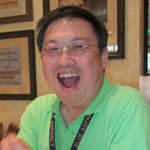Dr. Martin W. Lo
Former Mission Design and Navigation Manager Jet Propulsion Laboratory,
California Institute of Technology
 Since 1986, Martin Lo has been a research scientist in the Navigation and Mission Design Section at the Jet Propulsion Laboratory in Pasadena, California. He received his Bachelor of Science in 1975 from the California Institute of Technology in Mathematics and his PhD, also in mathematics, in 1981 from Cornell University.
Since 1986, Martin Lo has been a research scientist in the Navigation and Mission Design Section at the Jet Propulsion Laboratory in Pasadena, California. He received his Bachelor of Science in 1975 from the California Institute of Technology in Mathematics and his PhD, also in mathematics, in 1981 from Cornell University.
In 1995 Martin became the Research and Development Software lead for LTool, a high-level interactive, integrated object-orientated mission design programming environment. His work in the area reduced the time for a single Genesis trajectory generation from eight weeks to a few hours.
His most recent research interests include the discovery of the Interplanetary SuperHighway (IPS), a network of ultra-low-energy trajectory conduits generated by Lagrange Points throughout the Solar system. IPS plays a key role in the development of life within the Solar system and provides low energy orbits for many interplanetary missions.
From 1996 to 1999, Martin led the mission design of the Genesis
Discovery Mission. The Genesis solar panel wind sample return trajectory is
one of the most unique and difficult to be flown by JPL in recent years and
due to the fact that IPS trajectory requires no deterministic maneuvering after
launch, it was the first mission designed with dynamical systems methods. Genesis
was launched on August 8th, 2001.
Dr. Martin W. Lo is a member of the Navigation and Mission Design Section at the Jet Propulsion Laboratory, California Institute of Technology. Lo received his PhD from Cornell University (1980) and his BS from the California Institute of Technology in mathematics. As Mission Design Manager, he led the development of the trajectory for the Genesis Mission which launched on August 8, 2001 and is now collecting Solar Wind samples in orbit about L1. He is currently supporting the mission design and technology development of the Terrestrial Planet Finder mission.
He is the organizer of the Lagrange Group, an interdisciplinary and international group of researchers and engineers from universities, NASA centers, and industry whose focus is on the development of nonlinear astrodynamics techniques with applications to space missions and dynamical astronomy. At the request of the NASA Exploration Team, he demonstrated that formation flight in halo orbits is practical for the Terrestrial Planet Finder mission from the trajectory and mission design point of view.
He also conceived of a novel approach for human servicing of libration missions such as the Terrestrial Planet Finder at a Gateway Module in halo orbit about the Lunar L1. This provides a cost effective and efficient approach for human servicing. The spacecraft requiring service may be moved between the Earth libration orbits and the Lunar Gateway module via ultra low energy trajectories in the InterPlanetary Superhighway. This is a vast system of tunnels and passageways in space, discovered by Lo, which connects the whole Solar System and is generated by the Lagrange Points of all of the planets and moons. Not only does the InterPlanetary Superhighway provide low energy orbits for space missions, it is also traveled by comets and asteroids throughout the Solar System. Comet Shoemaker-Levy 9 and the asteroid which killed the dinosaurs both traveled in impact orbits which are similar to the Genesis orbit. Thus the InterPlanetary Superhighway is crucial to the development of life on Earth. Lo believes that the InterPlanetary Superhighway may play a key role in our understanding of low-thrust trajectory design for spacecraft using advanced electric or nuclear propulsion.
He is also leading the development of LTool, JPL's new mission design tool which uses dynamical systems techniques, or "chaos theory" to design highly nonlinear trajectories. His professional interests include mission design, the three body problem, satellite constellation coverage analysis, dynamical astronomy, applied dynamical systems theory, and computational mathematics.



